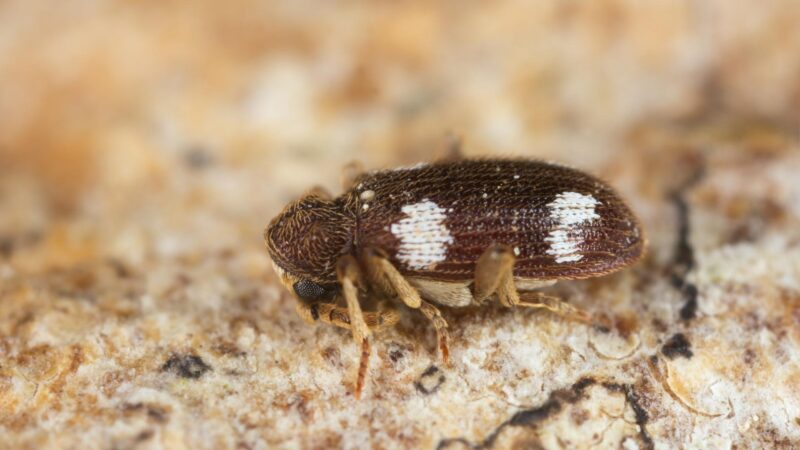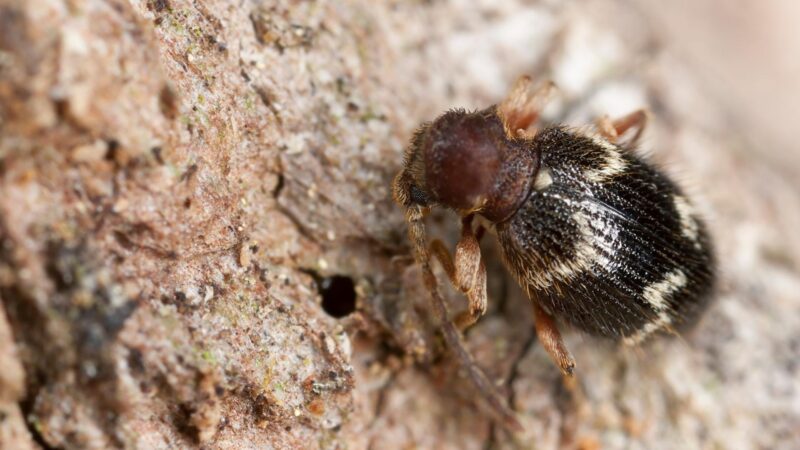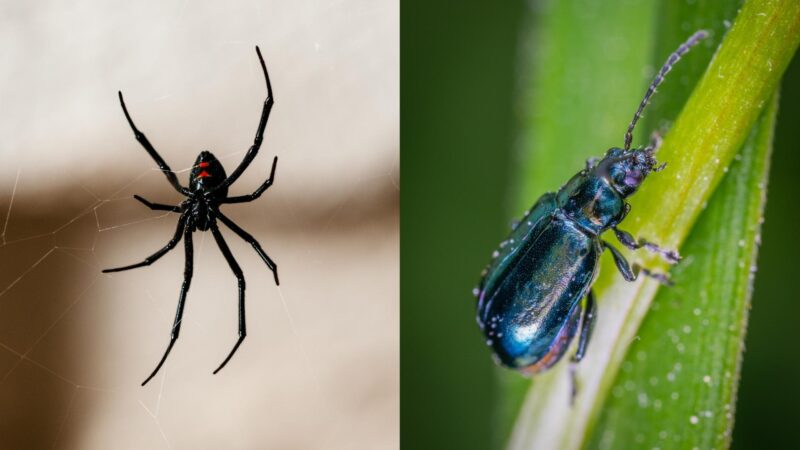Spider beetles are very tiny beetles that can cause an infestation in your pantry if ignored. Both the adults and larvae are pantry pests, but they may also be found in other moist places inside the house.
Many people think that they are spiders, not beetles. Spider beetles are sometimes thought of as biting people.
Do spider beetles bite? Spider beetles don’t bite or sting. Unlike bigger beetle species, their jaw muscles are not strong enough to break human skin. These beetle species are also not considered dangerous to public health. But still, a huge population can cause severe damage to stored dry food and food preparation.
Unfortunately, there is not much information about spider beetles. This is probably because they are not as popular as most pantry pests.
But because they are attracted to different kinds of food, they can easily spread almost everywhere. This article has everything you need to know about spider beetles.
What Are Spider Beetles?

Spider beetles are tiny beetles that belong to the subfamily Ptininae (family Anobiidae). They are commonly found in grain mills, warehouses, museums, and other wet places where they can find food.
This beetle species may not be as common as other pantry pests but can still cause severe trouble in your house.
There are several spider beetle species globally, but only three are common in the United States. They are the American spider beetle (Mezium americanum), the whitemarked spider beetle (Ptinus fur), and the smooth spider beetle (Gibbium aequinoctiale). Spider beetles are nocturnal insects or are most active at night.
How Long Do Spider Beetles Live?
Adult spider beetles live from 6 to 15 months, but females tend to live longer than males. Eggs hatch within 2-3 weeks and larvae undergo 3 instar stages, which last between 2 and 3 months.
The pupal stage may take 15-20 days, but some adults may stay inside the cocoon longer until they become sexually mature.
Can Spider Beetles Fly?
Most spider beetle species cannot fly because they have no wings. Both the American spider beetle and smooth spider beetle have wings.
However, they still cannot fly because their wings are hardened and fused together. Some male whitemarked spider beetles fly, but their females don’t because they are wingless.
How to Identify Spider Beetles?

Spider beetles look like small spiders, which is why they are called such. When viewed from above, spider beetles have globular abdomens, and their head is somehow hidden.
They are about 2-5 mm. long and have six long legs. Their body can be light reddish-brown or black and is covered with colored hair.
Spider beetles are closely related to cigarette beetles (Lasioderma serricorne) and drugstore beetles (Stegobium paniceum).
These three beetle species are somehow look-alikes since all of them have a strong humped appearance. Larvae of all spider beetle species have a cream C-shape body and look the same.
What Do Spider Beetles Eat?
Spider beetles eat a wide variety of dried stored products, including grains, seeds, flour, herbs, chocolate powder, cornmeal, as well as dried fruits and vegetables.
They may also eat dried insect collections and specimens, insect carcass and excrement, stuffed birds, fabric, leather, silk, old wood, and wool.
Do Spider Beetles Eat Spiders?
Spider beetles don’t eat spiders, but they feed on dead insects. These beetle species are mainly scavengers of dry food and plant materials but will also eat animal matter such as feathers, skin, and feces.
However, some beetle species, such as strawberry ground beetles (Pterostichus melanarius) may eat spiders.
How Do Spider Beetles Enter Houses?
Spider beetles rarely enter houses by themselves. Instead, they are accidentally brought inside through tampered food packages. Since these pantry pests are very small, they can easily hide in cracks and crevices in dry food storage areas. Spider beetles can also chew small holes in food packages, especially plastic.
Are Spider Beetles Harmful?
Spider beetles are not harmful to humans and pets. They also don’t carry serious illnesses and don’t cause damage to properties. Instead, they will ruin your dry food stored in the kitchen and pantry.
The only harm that spider beetles can do to people is when they contaminate food, which can no longer be eaten.
Do Spider Beetles Bite Humans?
Spider beetles don’t bite humans. This is even though some people have claimed that spider beetles bite. Although spider beetles may be inside your house, they infest on dry food but are interested in humans.
In most cases, people mistake bed bugs for spider beetles since both of them are very small.
What Does a Spider Beetle Bite Look Like?
As mentioned earlier, spider beetle bites don’t exist. If you have been bitten by an unknown insect or bug and your skin starts to feel itchy, it is not due to spider beetles.
If you spot something that looks like a spider beetle, it may be a bed bug. Note that bed bug bites are initially painless but can turn into a red, itchy bump.
What Is the Difference Between a Spider and a Beetle?

To start with, spiders are not insects but are rather arachnids, like scorpions, mites, and ticks. On the other hand, beetles are insects, like flies, moths, and butterflies.
But while both species are invertebrates or animals that have no backbone, spiders and beetles differ a lot when it comes to physical appearance:
- Spiders have two sections of their bodies – abdomen and prosoma (also called cephalothorax), wherein the head and thorax are fused together. Beetles have three sections – the head, thorax, and abdomen.
- Spiders have eight legs, while beetles have only six legs.
- Spiders don’t have antennae, while beetles have long antennae.
- Most spiders have 8 eyes, although some species have only six or fewer. Beetles usually have 5 eyes only, but they have better vision than spiders.
- Spiders have simple eyes, while beetles have both simple eyes and compound eyes.
- Spiders don’t have wings, which means that they cannot fly. Most beetles have wings, but some of them don’t fly because their wings are hardened.
- Beetles have mandibles, which they use for biting, cutting, digging, and capturing prey. Spiders don’t have mandibles, but they have chelicerae or mouthparts, which they use for chewing and injecting venom into their prey.
Beetles and spiders also differ in their life cycles. Like most insects, beetles go through complete metamorphosis. This means that they have four developmental stages – egg, larval, pupal, and adult.
Meanwhile, spiders only have 3 life stages – egg, spiderling, and adult. Spiderlings look like adult spiders but are much smaller.
Related: Are Spiders Insects (Bugs), Arachnids, Mammals, or Reptiles? | Taxonomy and Systematics
How to Identify a Spider Beetle Infestation?
Like other pantry pests, spider beetles can infest dry food in kitchens and pantries. Aside from that, they may also be present in attics and other areas where bats or rodents could be hiding.
Unfortunately, finding these scavengers can be difficult. To help you, here are some signs of a spider beetle infestation:
- Inspect all stored dry food packages thoroughly. Check for very tiny holes, webbings, and shed body parts.
- In the attic, check for signs of rodents or bats, their nest, or droppings.
- For severe infestation, you may find spider beetles inside your leather shoes that you seldom wear.
- If you have decaying wood or pieces of wood in wet areas, spider beetles may also be present.
Why Is There a Spider Beetle in My Bed?

First of all, a spider beetle would rarely be in your bed. This is because these beetle species don’t suck blood and will not get any benefit from humans.
Chances are you saw a bed bug, and you thought it was a spider beetle. But if it is a spider beetle, then it must have been accidentally gotten there.
How Do I Get Rid of Spider Beetles in My Bedroom?
Since there is very little chance that spider beetles would enter your bedroom, it is also very unlikely to have lots of them. To get rid of them, use a vacuum cleaner such as Shark NV352 Navigator Lift Away Upright Vacuum . This vacuum cleaner has a crevice tool attachment that can get through tiny cracks.
If spider beetles are in your bed, wash all the bedding, blankets, and pillows with hot water and detergent. For your mattress, vacuum or spray it with vinegar solution – two parts water, one part white vinegar, and a few drops of detergent. You may also sprinkle baking soda over the entire mattress, and leave it overnight.
How to Kill Spider Beetles?
Spider beetles are quite hard to kill because of their very small size. If they are in food packages, using insecticides is not recommended. But if you have to, make sure you remove all the food packages that can be contaminated. So aside from using a vacuum cleaner, here are other ways to kill spider beetles effectively:
- For severely infested dry food products, throw all of them away. This will also help prevent spider beetles from spreading.
- For food packages that are suspected to have spider beetles, don’t throw them away. Instead, place them in the freezer at 0°F (-17.8°C) for at least 4 days.
- Alternatively, heat them in an oven at 130°F (54.4°C) for at least 30 minutes.
- Throw away decaying wood and wooden furniture or burn them outside.
- Use a residual insecticide spray such as Paragon Conquer Residual Insecticide Concentrate . Before spraying, remove all food packages from shelves. Allow it to dry before returning the packages.
Are There Spider Beetle Traps?
There are traps for spider beetles. There are no specific glue traps for spider beetles, but you can use sticky traps for pantry moths. Products such as Trap A Pantry Moth Traps have pheromones that can attract all kinds of pantry pests. For better results, place them near your stored dry food packages or containers.
Summary
There might not be much to fear about spider beetles, but you should be aware of them. Getting rid of them in the pantry or kitchen does not necessarily mean you already solved the problem. The key here is to prevent them from entering your house. If infestations become uncontrollable, call a pest control service immediately.
List of Sources
SpJacobs, S. (2017). Spider Beetles. PennState Extension.
Ebeling, W. Urban Entomology Chapter 7. University of California Riverside – Department of Entomology.
Spider Beetle. Iowa State University.
Koehler, P. G., Chan, W. -H. (2022). Pantry and Stored Food Pests. University of Florida.
- How to Get Rid of Copperheads | Practical Guide - August 27, 2023
- How to Get Rid of Corn Snakes | What Makes Them Aggressive? - August 27, 2023
- How to Get Rid of Alligators | Safety Measures and Removal Methods - July 16, 2023
